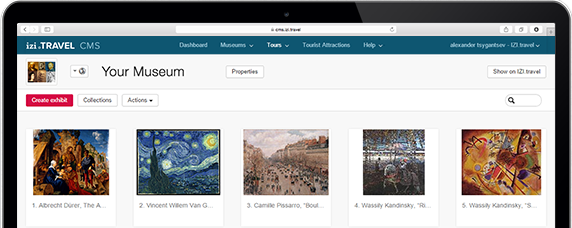The statues sculpted by Donatello and Michelangelo
Now let's move a few metres to our right to face the statue of a lion. It’s the 1st of 4 statues that we’re now going to describe on the esplanade before the Palazzo Vecchio. Off you go.
Bear in mind that the 4 statues we’re now going to discuss are eminently emblematic of the city of Florence. Are you in front of the lion at the left hand corner of the esplanade? Right, well this is the heraldic lion of Florence and next to it stands a statue of Judith and Holofernes. Further off to the left of the entrance to the Palazzo Vecchio stands a massive statue of David by Michelangelo and finally to the right of that entrance, a statue of Hercules and Cacus. Ostensibly, these themes and styles seem to have little in common with one another. However, despite this initial impression, all these statues have an essential common feature – they’re all republican symbols. Why is that? Firstly, because they’re all standing in front of the Palazzo Vecchio which was built to house the government of the Florentine Republic. Secondly, because they almost all date from the period of the Florentine Republic. It began in the 12th century and was crushed in 1530 when Emperor Charles the 5th appointed a duke in its place.
Additionally, these statues are of interest for a number of reasons. Each one of them – in its own way – recounts an important episode of the city’s history and, furthermore, was sculpted by one of 2 major artists, Donatello and Michelangelo. We’re going to describe each one in turn from a political rather than stylistic point of view. Each of these statues was knowingly placed here for purely political reasons alongside the seat of government of the city. At any moment feel free to move on to the next statue, if you so wish. Let's begin with the lion sculpted by Donatello.
With the coat of arms held firmly under its paw, this lion became the symbolic creature of the city back in the times when the Guelphs, or Papal supporters, finally seized power in the 13th century. The opposing Ghibelline faction used the imperial eagle as their symbol. From then onwards, the lion adorned the city monuments and family coat of arms and you’ll see numerous examples for yourself as you wander through Florence! In fact, if you look now to the right you’ll see that the steps of the arcaded Loggia are indeed flanked with statues of lions. The image of the lion is also to be found in other cities which came under Florentine rule. Furthermore - and a rather exotic detail - would you believe Florence even had its own menagerie of lions? The beasts were on show to the general public and their behaviour interpreted as an omen. A 14th century chronicler wrote, for example, that the birth of 2 lion cubs was considered a very fortunate omen for the town.
However, let's come back to this statue and the coat of arms. It features a red lily on a white background which is another heraldic emblem of Florence and is to be seen throughout the city. Just as an example, look up at the Palazzo Vecchio where you’ll see this coat of arms above the top windows. A white lily on a red background was the crest of the Ghibellines whereas this red lily on a white background was that of the Guelphs. The lily itself is usually thought of as being French and there’s good reason for its presence here as it originated with the arrival in Florence of Charles of Anjou, brother to the French king, Louis the 9th . He was asked by the papal supporters, the Guelphs, to assist them in their struggle against the Holy Roman Emperor who controlled the Italian peninsula at the time. It was thanks to his intervention that the Guelphs were able to establish their supremacy once and for all in 1266.
Let's come back to this statue. This lion goes by the name of Marzocco, in memory of an ancient statue of the god Mars which is no longer in existence but which between 1420 and 1810 stood by the Ponte Vecchio bridge, not far from here.
Let's take another look at this lion and - in particular - its jaws and the paw resting on the crest. Note its calm strength and power, symbolic of a specific political concept - that of the Republic. This statue dating from 1420 was the work of Donatello, the greatest sculptor of the Florentine Renaissance. This is in fact a copy as the original is located here in Florence in the Bargello Palace, a showcase of one of the most magnificent collections of Italian Renaissance sculpture.
Photo Florence - David and Duomo (4249173546) by Greg Willis under CC BY-SA 2.0Download the free izi.TRAVEL app
Create your own audio tours!
Use of the system and the mobile guide app is free


